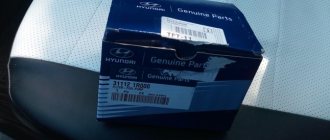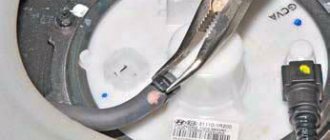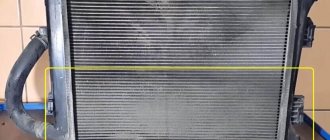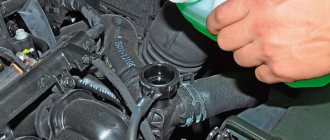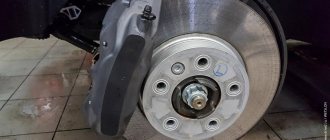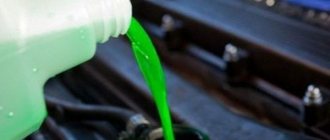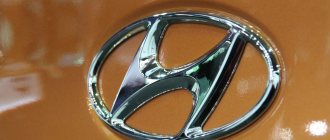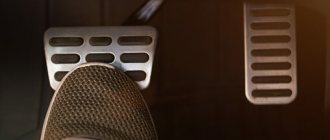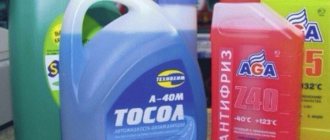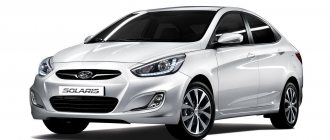Maintenance of each, even the most inexpensive car, is carried out strictly according to the regulations established by the manufacturer. Nevertheless, the item on replacing the brake fluid has disappeared from the Hyundai Solaris maintenance list for the last two years. This is due to many nuances, but the main one is the reduction in the cost of scheduled maintenance.
However, it is necessary to change the fluid, and today we will figure out how to do this, what kind of fluid is used in the system and when replacement is necessary.
Regulations for replacing brake fluid on Hyundai Solaris
Two questions that a car enthusiast faces are when and how to change it. To answer the second question, you need to know what brake fluid to fill in the Hyundai Solaris, taking into account its technical characteristics and the brands previously used in the car.
The characteristics of the brake compound, which must be taken into account when replacing it, are:
- compression ratio, the driver should be interested in the maximum indicator;
- its properties, especially water-repellent and anti-rust;
- boiling point (maximum possible);
- non-aggression. In contact with rubber parts, the liquid should not cause them to deteriorate.
All these characteristics are difficult to control, so when filling it is necessary to rely on factory brands and manufacturer’s recommendations.
For Hyundai, the period when the brake fluid should be changed is also determined by the technical documentation, but can be adjusted taking into account the operating conditions.
Conclusion
On the one hand, replacing brake fluid in a Hyundai Solaris is simple, especially for those who have already carried out such a process. For a beginner, this procedure may seem quite difficult to understand, and even more so to perform, so in this case it is recommended to contact a car service.
The car requires the attention of the owner, if you are an owner who does not particularly care for his car, then you still have to do it. Of course, not all parts need to be changed and all that, but the filling fluids in cars definitely need to be changed! If you don't believe us, then ask a good auto mechanic. And so closer to the point, the Hyundai Solaris car is no different (in particular) from other cars. And so on this page we will look at how much and what kind of liquid you need to pour into your car.
What's already in the car?
The Korean auto giant releases its models from the assembly line, filling them with DOT-4 class fuel oil. Its manufacturer is not determined, it is marked as Hyundai/Kia 01100-00110 BRAKE FLUID.
It is not always possible to purchase a similar one for replacement, but here the car enthusiast has the opportunity to choose any brand if it meets the criteria applicable to the DOT-4 standard, regardless of the specific manufacturer.
You need to purchase the volume of liquid that will replenish the entire amount in the vehicle. This is approximately 1.25 liters. But if we take into account the volume that is located in the clutch drive, the total result is 1.75 liters.
Use of cookies
This Web resource (hereinafter referred to as the Site) uses “cookies”, including collecting the following information about Users in order to improve the operation of the Site. Processing of information about Users is carried out in accordance with the Policy in the field of processing of personal data of Hyundai Motor CIS LLC.
This site uses the Yandex.Metrica web analytics service provided by , 119021, Russia, Moscow, st. L. Tolstoy, 16 and the web analytics service google.ru/analytics provided by .
These services use “cookie” technology - small text files placed on users’ computers for the purpose of analyzing their user activity. Information collected using cookies (user's IP address, date and time of visiting the site, types of browser and operating systems, type and model of mobile device, source of entry to the site, information about user behavior on the site (including the number and name of pages viewed), age , gender, interests, geographic location of the user, other technical data (cookies, flash, java, etc.) cannot identify you, but can help us improve the operation of our site. Information about your use of this site collected using cookies, will be transferred to YANDEX LLC and GOOGLE LLC, which will process this information to evaluate your use of the site, compile reports for us on the activities of our site, and provide others and GOOGLE LLC process this information in the manner established in the terms of use services.
You can refuse the use of cookies by selecting the appropriate settings on your browser. By using this site, you consent to the processing of data about you in the manner and for the purposes stated above.
When to change?
Replacing the Hyundai Solaris brake fluid as standard, based on the requirements of the regulations, is carried out:
- during scheduled maintenance;
- every 2 years of intensive use (but if the car is in a garage, the period increases);
- every 30 thousand km.
Now the owner has more freedom and can independently determine the replacement schedule. The price of the liquid is about a thousand rubles per liter, which allows you to save on its timely replacement. Why is it so important?
Required Tools
To replace you will need:
- A syringe or bulb for pumping brake fluid from the reservoir;
- Rags;
- Metal brush;
- A couple of liters of water;
- A thin hose that will be used to drain liquid from the fittings;
- Container with a volume of 300-500 ml;
- Brake fluid about 1 liter;
- Socket wrench for unscrewing fittings on brake cylinders;
- a partner who will help.
It is recommended to change the Hyundai Solaris brake fluid every 2 years or every 45,000 km, since it is hygroscopic and when moisture gets into it, the boiling point of the fluid decreases, and during intense braking, the system mechanisms become very hot, which can cause the brake fluid to boil and reduce the effectiveness of the brakes . Moisture also causes corrosion of the internal surfaces of the brake mechanisms, which will further lead to leakage, jamming, breakdown and replacement of these components. You can easily change the brake fluid yourself.
We recommend using the DOT 5 brand, since it meets more stringent requirements, and its price differs only slightly from DOT 4. The market is replete with different manufacturers, it’s up to you to decide which one to choose.
DOT-4
When studying the behavior of a liquid of this standard under intensive use, it turned out that in just a year its boiling point changes radically, it drops from 265 degrees to just 165. The reason for this is a change in structure - air bubbles appear in the liquid.
And the power impulse from the amplifier to the brakes is no longer transmitted so intensely. In practice, this looks like pedal failure. This indicates a decrease in the level of vehicle safety. In addition, its structure is affected by contact with moisture. Based on this decrease in the consumer characteristics of the vehicle, replacing it annually or once every 30 thousand km is justified.
adviсe
The nominal volume of the internal channels of the cooling system is 5.3 liters. Since the drain is done only from the radiator part and the expansion tank, coolant remains in the engine and heater radiator. Therefore, the amount of water is about 4 liters.
When changing the composition, an air lock may be created. If it has formed, and when the engine warms up, this will be indicated by the flow of cool air from the interior heating system, then you should stop the internal combustion engine and let it cool. After. Remove the radiator cap and start the engine for a couple of minutes. the air will come out.
Replacement process. Fast and correct
Replacing a TJ begins with its selection. The driver needs to buy suitable brake fluid for the Hyundai Solaris in a volume of at least 1.75 liters. Then you should invite an assistant; you won’t be able to carry out all the operations yourself.
Stages of work production:
- The machine is installed on a lift; free access to the mounting system for each of the 4 wheels is required.
- The engine turns off and cools down a little. Then the hood opens.
- The expansion tank plug is unscrewed. The old fuel fluid is pumped out with a syringe or rubber bulb.
- Check for any remaining liquid.
- A new fuel fluid is poured to the critical permissible level.
- Next, you need to bleed each wheel cylinder. The preferred bleeding order would be starting with the right rear, then the left front wheel, then the left rear. The process ends on the right front.
- Then the driver must go down to the bleeder fitting of the right wheel cylinder and clean it of dirt. Using a 10mm wrench, a hose is put on the fitting, its second end is lowered into an open white or transparent container, which allows you to control the color of the fuel fluid, where there is already at least 500 ml of new fuel fluid.
- The assistant must operate the brake several times, pressing and releasing the pedal, and then lock it in the pressed state.
- The fitting is pumped out half a turn. A replacement is taking place.
- Pumping continues until the fuel fluid begins to flow out of the hose, already clear and fresh. The fitting is tightened and the brake is released.
- Add liquid to the expander again to the limit.
- The operation is repeated on each of the remaining wheels.
Pointed question: what happens if you mix antifreeze of different brands and colors and the consequences
Before adding anything to the expansion tank, you should once again ask what brand of coolant is filled. After all, by mixing mixtures prepared on different bases, you can simply clog the channels of the engine cooling jacket.
Since the manual correctly states that the composition should be ethylene glycol, the product can only be topped up on this base. It is allowed to diversify by manufacturers and brands. under no circumstances.
READ What antifreeze to fill in Chevrolet Cruze
What happens if you connect? Everything is quite basic. Corrosion inhibitors are of different types; with their assistance, sediment or flakes may be released.
Many motorists struggle with the question: what if you mix antifreeze of different colors and what will happen after that? The answer is simple. nothing, as long as the base is the same. Generally speaking, there are standards for colors. Different companies use different pigments.
For your information. In the absence of Antifreeze, small additions into the Solaris expansion tank will completely drain distilled water (within the range of 100-500 ml).
Second replacement method
The video below will help you understand the mechanism for replacing the brake fluid of the Hyundai Solaris. But there is another way; in this case, you don’t need an assistant. An experienced mechanic will show you all the steps in practice and help you avoid mistakes. But when implementing the method, you will need 4 separate containers and 4 hoses.
The process goes like this:
- The hood opens, the old fuel fluid is pumped out, the new one is filled to the maximum.
- Access to all 4 fittings is available; hoses are put on them, which are lowered into containers with liquid.
- The fittings are put on in place only after there is 250 ml of TJ in the containers.
- When replacing, it is necessary to constantly monitor the level of fuel fluid, add as much as necessary to avoid the appearance of air locks.
This method is less economical since it will require slightly more liquid than is necessary to fill the system. Self-replacement is quite simple and can be repeated after every 30 thousand km without any particular difficulties for the driver.
Filling tanks for fuel and lubricants Hyundai Solaris
| Filling/lubrication point | Refill volume | Name of oil/liquid |
| Fuel tank | ||
| Before restaling | 43 liters | Gasoline no less than 92 |
| After restaling | 50 liters | |
| Engine lubrication system (including oil filter) engines: | ||
| 1.4 liters | 3.3 liters | Oil type according to SAE^ 5W20 or 5W30; via API: SM |
| 1.6 liters | According to ILSAC GF-4 | |
| Engine cooling system: | ||
| 1.4 liters | 5.3 liters | Antifreeze safe for aluminum radiators with distilled water |
| 1.6 liters | ||
| Transmission | ||
| Manual transmission | 1.9 liters | According to API: GL-4; according to SAE: 75W85 |
| Automatic transmission | 6.8 liters | Diamond ATF SP-III or SK ATF SP-III |
| power steering | 0.9 liters | Ultra PSF-3 03100-00100 or Ultra PSF-3 03100-00110 |
| Brakes | 0.8 liters | DOT-3 or DOT-4 |
What and how much to fill in Hyundai Solaris
Engine oil
The Hyundai Solaris is equipped with two engines of 1.4 liters and 1.6 liters, both petrol. The volume of filling liquids is the same, it is equal to 3.3 liters. SAE oils can be used 5W20 or 5W30, at your discretion. According to API only SM, and according to ILSAC GF-4. Either pour original, branded oil, or buy a different one, but so that everything is normal.
Oil for automatic transmission and manual transmission.
For a manual transmission we buy oil according to API GL-4, and according to SAE 75W85, you need to fill the oil in the box with 1.9 liters.
For automatic transmissions, the fluid is Diamond ATF SP-III or SK ATF SP-III. Automatic transmission volume = 6.8 liters, more will be required than for a manual transmission.
The power steering fluid is Ultra PSF-3 03100-00100 (to make it easier for you, it is red), or fill it with Ultra PSF-3 03100-00110 (light brown). Fill in 0.9 liters.
Coolant.
We fill in Antifreeze safe for aluminum radiators with distilled water, pour in a total of 5.3 liters.
Brake system
The brake fluid is DOT-3 or DOT-4, it makes no difference, but the volume is 0.8 liters.
Before the restaling, the car’s tank was 43 liters, but after its release in 2022, the car’s tank was 50 liters.
Gasoline for both needs to be filled with at least 92, but for better engine performance it is better to pour 95 gasoline.
Volume of oils and fluids Hyundai Solaris was last modified: October 2, 2022 by Administrator
Replacing brake fluid in Solaris is a mandatory procedure that is performed every 2 years of vehicle operation or upon reaching 30 thousand kilometers. This recommendation is specified in the maintenance manual, which is mandatory for users and service centers.
Briefly about the main thing
For anyone who is interested in what kind of antifreeze to pour into a Hyundai Solaris car, the advice is as follows:
- Hyundai Long Life Coolant (concentrate).
- Crown LLC A-110 / Coolstream A-110.
- Shell GlycoShell Longlife or Shell Premium Antifreeze.
In general, the plant suggests pouring in mixtures only based on ethylene glycol. According to WAG specification. this is G11.
Combining compositions of different colors is allowed. It is also allowed to combine formulations from different manufacturers. It is forbidden to mix cooling waters of different bases, in other words brands.
https://autostadt.su/antifreeze-dlja-hyundai-solaris/
